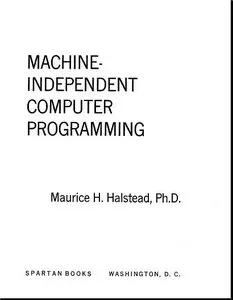October 2025
| Su | Mo | Tu | We | Th | Fr | Sa |
|---|---|---|---|---|---|---|
| 28 | 29 | 30 | 1 | 2 | 3 | 4 |
| 5 | 6 | 7 | 8 | 9 | 10 | 11 |
| 12 | 13 | 14 | 15 | 16 | 17 | 18 |
| 19 | 20 | 21 | 22 | 23 | 24 | 25 |
| 26 | 27 | 28 | 29 | 30 | 31 | 1 |
Attention❗ To save your time, in order to download anything on this site, you must be registered 👉 HERE. If you do not have a registration yet, it is better to do it right away. ✌

SpicyMags.xyz

SpicyMags.xyz
Maurice H. Halstead: Machine-Independent Computer Programming
Date: 8 Feb 2009 13:57:00
PREFACE
This text is based upon the lecture notes developed by the author
while teaching an evening course, described as "N eliac, a Dialect
of Algol," for the University of California Extension. This course
was taught twice, in each case to a group which was extremely
heterogeneous, including both experienced programmers and others
who were completely unfamiliar with computers. Further, the
interests of the students varied widely from individual to individual,
including business, engineering, mathematics, and real-time control.
In an effort to interest and challenge all groups simultaneously,
a basic self-compiler written for the purpose was used as the
principal example. This compiler, which is covered in Chapters
5 through 10, served as neutral material from which the novices
in various fields could develop proficiency in both the language
and in the type of thinking required in handling computers, while
at the same time it provided the devotees with the necessary background
from which they themselves soon started suggesting more
efficient routines and improved techniques in the writing of compilers.
The many contributions of these students are gratefully
acknowledged.
From the foregoing it may be seen that this book is designed to
teach the student how to "write to" computers in the Neliac lan
guage, and then to teach him how to "teach" a computer to read
Neliac if it does not already know.
Returning to the preparation of the text, it would not be proper
to confuse the latter with the development of the concepts it describes.
These concepts result from the work of many pioneers in
the computer field, as well as others such as Charleton Laird,
whose penetrating work The Miracle of Language is not concerned
with computers at all. The basic concepts involved were crystalized
primarily at the Navy Electronics Laboratory, where Roger Remple,
Lt. Kleber Masterson, Lt. Comdr. Robert McArthur, Dr. Robert
Goss, Lt. John White, Ens. Arthur Lemay, Sidney and Catherine
Porter, Robert Johnson, Charles Tappella, Herman Englander, Joel
Donnelly and James Warrington each have made contributions to
one or more of the family of Neliac compilers. The work of automatic-
programming experts at other installations, including Prof.
Richard Thatcher, 'Vesley Landon and Dr. W. H. Wattenburg, has
also been of great value, while the advice and inspiration of Prof.
Harry Huskey has been basic to the entire development.
Special thanks are due to Joel Donnelly, Lt. White, Ens. Lemay,
and Sidney and Catherine Porter, and to the Technical Director
of the U. S. Navy Electronics Laboratory for permission to cite
those works given in the appendices.
Finally, the author wishes to apologize for whatever deficiencies
exist in the presentation, asking indulgence on the grounds
that the field of automatic machine-independent programming is
still quite new.


